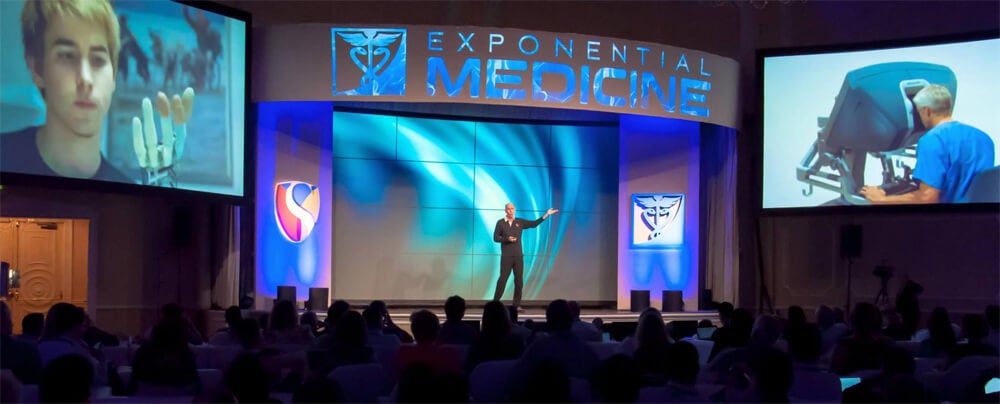Exponential Medicine 2014 Conference Kicks Off in San Diego

Share
The weather is fine and the future on display. I'm in San Diego covering Singularity University’s Exponential Medicine conference through Wednesday. The four-day event kicked off yesterday at the Hotel Del Coronado in San Diego, where Singularity University (SU) faculty set the frame of reference—technology’s exponential pace.
A theme seemed to run through the first talks. As many industries increasingly embrace the digital age, healthcare needs to catch up. But healthcare will catch up. According to Peter Diamandis, cofounder and SU executive chairman, no industry or field stands to face more disruption or greater reinvention than healthcare in the next decade.
“We’ll make each individual a CEO of their own health,” Diamandis said.
What’s the driving force? Diamandis noted the 100-billion-fold improvement in computing power brought on by the last forty years of Moore’s Law. But it isn’t just computing that’s special. The convergence of computing with cheaper, more powerful sensors is set to deliver a host of health technologies.
Early GPS units cost on the order of $120K and were sizable beasts. Now they come stock in your average smartphone. The gyro on that same phone? That was the size of a podium, consumed a few hundred watts of power, and cost $250K on the Space Shuttle. Now, it’s the size of a fingernail, costs a buck, and at one point, guided a $30 mini-drone through a series of autonomous flips on stage during a talk on robotics by Singularity University's Dan Barry.
And of course, health sensors measuring an increasing list of vital signs are undergoing a similar transformation.
Sensor-driven health technologies are just now getting underway—and I'll likely have more on them later—but as Daniel Kraft, Exponential Medicine’s founding executive director noted, more regular measurement of our body’s vital signs will shift healthcare from intermittent and reactive to continuous and predictive.
“We’re in an era of prescribing apps and devices,” Kraft said.
But it isn’t just sensor-driven healthcare. Andy Christensen, 3D Systems VP of Personalized Surgery and Medical Devices, described the power of medical 3D printing—personalized implants, better preparation through simulated surgery, tailored templates for complex operations, and custom braces and prosthetics that could be made no other way.
Be Part of the Future
Sign up to receive top stories about groundbreaking technologies and visionary thinkers from SingularityHub.


Christenson reminded the audience of the oft quoted phrase, in 3D printing "complexity is free."
What else? According to Raymond McCauley, SU biotech track chair, we’re undergoing a genetic engineering renaissance. In vitro fertilization already allows for early genetic testing and embryo selection, but rapidly advancing techniques, like CRISPR, allow us to knock out, knock in, repair, and edit the genome in “drag and drop” genetic engineering.
What might these capabilities yield in the future? Researchers already know that some people lacking particular genes are more resistant to flu, HIV, cardiac, and Alzheimer’s disease and have stronger bones and leaner muscles. McCauley said knocking out these genes in the rest of us could one day confer similar advantages.
The stage is set for an interesting few days with talks ranging from artificial intelligence, big data, and connected health to genomics, regenerative medicine, and longevity.
Stay tuned or tune into the live stream here.
Image Credit: Shutterstock
Jason is editorial director at SingularityHub. He researched and wrote about finance and economics before moving on to science and technology. He's curious about pretty much everything, but especially loves learning about and sharing big ideas and advances in artificial intelligence, computing, robotics, biotech, neuroscience, and space.
Related Articles

Single Injection Transforms the Immune System Into a Cancer-Killing Machine

New Gene Drive Stops the Spread of Malaria—Without Killing Any Mosquitoes

New Immune Treatment May Suppress HIV—No Daily Pills Required
What we’re reading

